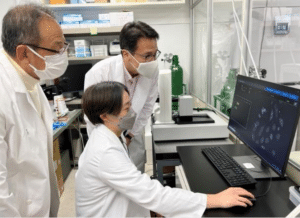Nanolive Revolutionizing Mitochondrial Therapy Research in Japan: “Seeing is Believing”
Tolochenaz, Vaud, Switzerland — February 21st, 2023 – Nanolive SA, an industry leader in live cell imaging and analysis, announced today the installation of their CX-A imaging platform at LUCA Science’s Research & Development Center in Sapporo, Japan.
LUCA Science is developing a novel functional mitochondrial therapy using its proprietary mitochondria isolation technology to improve cellular bioenergetics in injured tissues. Nanolive’s label-free, live cell imaging solution advances mitochondrial research by permitting high-resolution visualization of mitochondrial dynamics with a low-intensity, non-invasive and non-phototoxic light source.

Dr. Hisashi Ohta, Head of Research and Development, Masae Takeda, Technical Staff and Ph.D. Candidate, and Dr. Rick C. Tsai, President and CEO of LUCA Science (left to right) review the first captures made with Nanolive’s CX-A platform.
“It’s very unique when you’re combining two cutting edge technologies; Nanolive’s imaging and LUCA’s Mitochondria, if one cutting edge technology shows something new, two will be even more powerful, so I hope we will be able to show many, many interesting discoveries” says Dr. Rick C. Tsai DMD, MD, President & CEO, LUCA Science Inc.
LUCA Science
LUCA Science’s catchphrase is “Energy for Life”, and their mission is to restore the energy needed for biological processes, by using energy-generating mitochondria themselves to treat patients and improve health. Powering LUCA Science is their isolated mitochondria Q which is in development for use as an off-the-shelf therapy to treat patients with dysfunctional mitochondria in mitochondrial diseases, improving CAR-T function, reducing ischemia-reperfusion injury, and other applications.
Nanolive imaging helped to prove therapeutic potential
After developing a proprietary method to isolate intact and functional mitochondria, the LUCA Science team discovered that even with simple co-culture, mitochondria Q were readily taken up by the cells in vitro. Thanks to Nanolive’s live cell imaging, the uptake of mitochondria Q was captured in real-time (video). President and CEO of LUCA Science, Dr. Rick Tsai told us “That short video from Nanolive has converted a lot of non-believers, seeing is believing.”

Fluorescently tagged mitochondria Q (red) are taken up by HeLa cells over the 3 h 44 min imaging period. Combining both refractive index and fluorescence imaging allows us to see how the mitochondria are able to pass through the plasma membrane, into the cells. Less than four hours after the start of imaging, many mitochondria had accumulated inside each cell.
Nanolive’s installation at LUCA Science, Japan
Nanolive installed the complete CX-A automated live cell imaging platform in LUCA Science’s research laboratory followed by curated training in image acquisition and analysis specific to their application in mitochondrial research. From the first acquisition, mitochondria were visible, completely label free. Combined with epifluorescence correlation, the LUCA team could easily differentiate their mitochondria Q from endogenous host cell mitochondria.
About Nanolive in mitochondrial research
Nanolive’s live cell imaging is a go-to method for investigating mitochondria, thanks to its ability to image mitochondria as well as other organelles label-free. This non-invasive approach allows high-resolution imaging over long periods of time without damage or disruption, for a more biologically relevant picture of mitochondrial dynamics and function.
Nanolive’s Head of AI for Quantitative Biology, Dr. Mathieu Frechin said “Joining forces with LUCA Science will allow us to expand our knowledge of possible mitochondrial shapes and dynamics and possibly shed light on completely new roles for exogenous mitochondria entering cells. We are thrilled!”
Dr. Tsai summarized his hopes for the Nanolive platform at LUCA Science: “There are still many discoveries to be made on exogenous mitochondria biology, I’m convinced when we image different conditions and cell types with this platform, there will probably be valuable world-first discoveries.”
About Nanolive SA
Nanolive develops and manufactures live cell imaging platforms and integrated digital analytical solutions powered by machine learning, to qualitatively and quantitatively analyze cells label-free. Nanolive’s first-in-class solutions have repeatedly been recognized by The Scientist’s Top 10 innovations in 2022 (The LIVE T Cell Assay), 2019, and 2015 (the CX-A and Cell Explorer imaging platforms, respectively). Nanolive is headquartered in Tolochenaz, Switzerland with staff worldwide including in China, France, Germany, and across the US where it operates as Nanolive Inc.
Recently published peer-reviewed papers where Nanolive has been used to image mitochondria are listed on Nanolive’s website.
About LUCA Science Inc.
LUCA Science is a Japanese preclinical biopharmaceutical company focusing on the development of novel mitochondrial therapies to treat diseases and injuries in multiple therapeutic areas by restoring cellular bioenergetics. LUCA Science has ongoing collaborations across Japan, the US, and the UK to research the clinical applications of their mitochondrial platform.
For Media Inquiries:
Nanolive SA
Route de Lully, 5B
1131 Tolochenaz
Switzerland


